|
|
|
Sort Order |
|
|
|
Items / Page
|
|
|
|
|
|
|
| Srl | Item |
| 1 |
ID:
172569


|
|
|
|
|
| Summary/Abstract |
Current dynamics in UCAV proliferation in the Middle East signal that combat drones have become key strategic enablers for state actors in the region, and are no longer seen as an optional asset. With the development of a multitude of indigenous UCAV projects, and the arrival of Chinese-made armed drones on the international market, military procurement in the Middle East has entered a new phase, in which possessing armed drone capabilities is becoming the norm. This article examines the operational and strategic considerations driving Middle Eastern states’ UCAV procurement policies, analysing those countries who have been focusing on armed drones for combat purposes and additional intelligence, surveillance, target acquisition, and reconnaissance (ISTAR) needs. The main drivers behind this trend are the operational and strategic advantages brought about by UCAVs, where the benefits related to cost, reliability, and operational risk mitigation are matched by the increased ability to project power that the platform allows, either through deniability or by making UCAVs available to proxies and allies.
|
|
|
|
|
|
|
|
|
|
|
|
|
|
|
|
| 2 |
ID:
172575
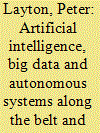

|
|
|
|
|
| Summary/Abstract |
China is pressing ahead with ambitious plans to create a massive infrastructure network connecting it with many countries across the globe. Some of the ‘belt and road’ infrastructure will however, run through regions convulsed by chronic civil unrest, substantial criminality and incipient insurgencies and need protection by China’s private security companies. Simultaneously the Chinese state is undertaking a major ‘anti-secession and counter-terrorism’ campaign in Xinjiang using a variety of high-technology means: artificial intelligence, big data, wireless connectivity, autonomous systems and robotics. The demand and supply sides seem to be in sync, suggesting Chinese private security companies will soon use a suite of advanced information technology systems with a proven employment doctrine across much of Central Asia, South Asia and Africa. Such a future may be plausible but it is by no means certain as various factors may yet thwart China’s private security companies.
|
|
|
|
|
|
|
|
|
|
|
|
|
|
|
|
| 3 |
ID:
172574


|
|
|
|
|
| Summary/Abstract |
There has been speculation for some time that unmanned ground vehicles (UGVs) are poised to revolutionize military land operations. These expectations have amplified with recent developments, not least the reported deployment and testing of Russian weaponized UGVs in Syria. Yet when it comes to the operational use of mobile ground-based robots – armed or otherwise – the recent history of the technology can be described as one of promise so far unfulfilled. By tracing past and present efforts to develop and field UGVs – and the enduring challenges that lie therein – this article attempts to gauge the likely impact of such systems in future conflict, as well as their effect on international security more broadly. The article concludes that although UGVs will almost certainly become a major – if not indispensable – feature of future military land operations, they will, similar to other promising militarily relevant technologies before them, continue to produce unrealistic expectations about their impending revolutionary effect.
|
|
|
|
|
|
|
|
|
|
|
|
|
|
|
|
| 4 |
ID:
172573


|
|
|
|
|
| Summary/Abstract |
This article explores the imprecise boundary between Lethal Autonomous Weapons Systems (LAWS) and Human-Machine Teaming – as a subset of Human-Machine Interaction – and the extent both are emerging as a point of concern (and option) in military and security policy debates. As the development of Human-Machine Teaming relates to artificial intelligence (AI) capabilities there also exists an area of concern pertaining to reliability and confidence, particularly in the heat of battle. Also known as Manned-Unmanned Teaming, Human-Machine Teaming attempts to engender trust and collaborative partnerships with robots and algorithms. Clearly the prospect of LAWS in recent times, or so-called ‘killer robots,’ has raised questions relating to the degree such devices can be trusted to select and engage targets without further human intervention. Aside from examining the ‘trust factor,’ the article also considers security threats posed by both state and non-state actors and the complicit yet inadvertent role multinational corporations play in such developments where civilian technology is modified for dual-purposes. The effectiveness of government regulation over AI, including whether AI can be ‘nationalised’ for national security reasons, will also be examined as part of AI non-proliferation.
|
|
|
|
|
|
|
|
|
|
|
|
|
|
|
|
| 5 |
ID:
172576


|
|
|
|
|
| Summary/Abstract |
Through a brief survey of the typical definitions of hybrid warfare (HW), this article illustrates the five salient features of HW: synergy, ambiguity, asymmetry, innovative disruption and battle over psychology; then based on a HW model proposed by Erik Reichborn-Kjennerud and Patrick Cullen, the article discusses the impact of Artificial Intelligence on the five instruments of power – military, political, economic, civil and informational (MPECI), and analyses the changes and continuities of HW in the age of Artificial Intelligence
|
|
|
|
|
|
|
|
|
|
|
|
|
|
|
|
| 6 |
ID:
172567
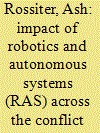

|
|
|
|
|
| Summary/Abstract |
Technology is often held up to be a key – if not the key, for some at least – driver in shaping the character or even perhaps the nature of war. The introduction of new technologies has resulted in novel and, usually by implication, more effective ways of conducting warfare. Indeed, many leading military thinkers have identified new technology – both of civilian and military origins – as the source of many of history’s military revolutions, or so-called major military innovations (MMIs), as others have termed radical change in military affairs.
|
|
|
|
|
|
|
|
|
|
|
|
|
|
|
|
| 7 |
ID:
172568
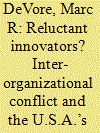

|
|
|
|
|
| Summary/Abstract |
Few innovations have marked the late-20th and early-21st centuries more than unmanned aerial vehicles, also known as drones. Drones’ current preeminence leads many to assume that their development was teleologically determined by technological advances. The empirical record, however, belies such assumptions and is filled with vicissitudes. The Air Force’s and Naval aviation’s pilot-dominated hierarchies never prioritized drones over manned aircraft of their own accord. Politicians, meanwhile, lacked the expertise to judge what technologies could achieve and therefore could not compel the military to embrace drones. It was, thus, competition from other organizations – the CIA, the Navy’s surface warfare community and the Army –that obliged reluctant aviators to embrace drones. My study’s key original finding is that inter-agency competition impels militaries to embrace technologies that they would otherwise reject. Warfare’s evolution means that non-military bodies – intelligence agencies, interior ministries and paramilitary forces – develop capabilities that rival those of traditional military services in specific domains and these organizations can prove more agile at adopting certain new technologies because of their flatter organizational structures.
|
|
|
|
|
|
|
|
|
|
|
|
|
|
|
|
| 8 |
ID:
172570
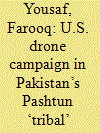

|
|
|
|
|
| Summary/Abstract |
The U.S. drone campaign in Pakistan’s Pashtun ‘tribal’ areas, formerly known as FATA, has remained one of the most contentious issues since the war on terror began in 2001 in Afghanistan. Though drone strikes have polarised opinions, they have also resulted in the elimination of lower, middle and higher-level leaders of all militant groups based in the ‘tribal’ region. The U.S. drone campaign in the former-FATA region had some success in the elimination of terrorists. But lack of access to the ‘tribal’ areas coupled with the secrecy surrounding the drone campaign resulted in major discrepancies in the total number of U.S. drone strikes and the resultant casualties. These factors have contributed towards an anti-drone and anti-U.S. narrative in Pakistan, largely manufactured by Pakistani mainstream media. With the last drone strike taking place almost a year ago, this article argues that the U.S. drone campaign may have finally halted in Pakistan. However, even with a gradual halt, the ‘tribal’ areas can witness drone strikes in the future if high-profile terrorists, based on actionable intelligence, are located in the region.
|
|
|
|
|
|
|
|
|
|
|
|
|
|
|
|
| 9 |
ID:
172571
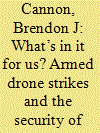

|
|
|
|
|
| Summary/Abstract |
Strikes conducted by the US using armed unmanned aerial vehicles (UAVs) against the terrorist group al-Shabaab have received widespread attention documenting the number of strikes, the reactions of the local Somalis, and the disparity between AFRICOM and local reporting. Using interview data from individuals in Mogadishu, Nairobi and elsewhere in the region, this article provides a counterpoint to previous studies by measuring the Federal Government of Somalia’s (FGS) reliance on the US drone campaign in Somalia in order to maintain its tenuous hold on power. It measures the extent to which the drone campaigns of external parties are able to insulate weak host governments from the threat of an internal foe. It finds that US drone strikes offer the occasional but only reliable check on al-Shabaab thereby allowing the FGS to continue functioning in Mogadishu. Yet strikes should not be construed as a sign of overt US support for the FGS. Rather, the US government, deeply suspicious of a highly corrupt and incapable FGS, continues to prosecute drone strikes against al-Shabaab because Washington considers the group poses a national security threat to the US.
|
|
|
|
|
|
|
|
|
|
|
|
|
|
|
|
| 10 |
ID:
172572


|
|
|
|
|
| Summary/Abstract |
Developments in artificial intelligence have ignited many debates on the use of autonomous weapons and ‘killer robots.’ However, before autonomous attack decisions can be explored, issues related to target selection need to be considered. Focusing the discussion on drones and artificial intelligence overshadows more fundamental issues. This paper therefore argues that the main ethical problem raised by autonomous drones do not come from the weapon system or technology itself. Instead, they stem from challenges of target identification. Thus, asking ‘what’s wrong with drones?’ is misleading as it focusses on the technology instead of the primary issue of target selection.
|
|
|
|
|
|
|
|
|
|
|
|
|
|
|
|
|
|
|
|
|